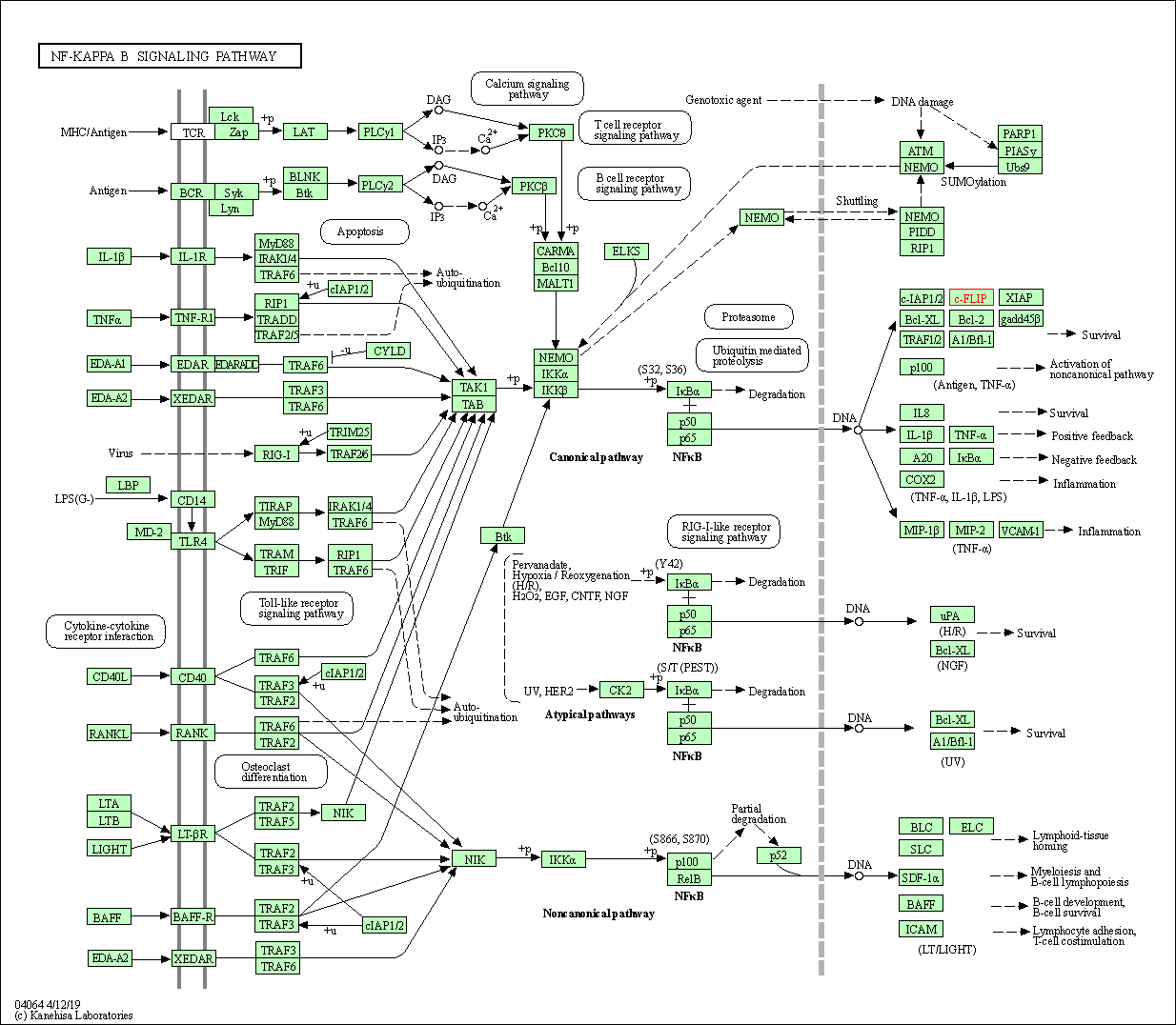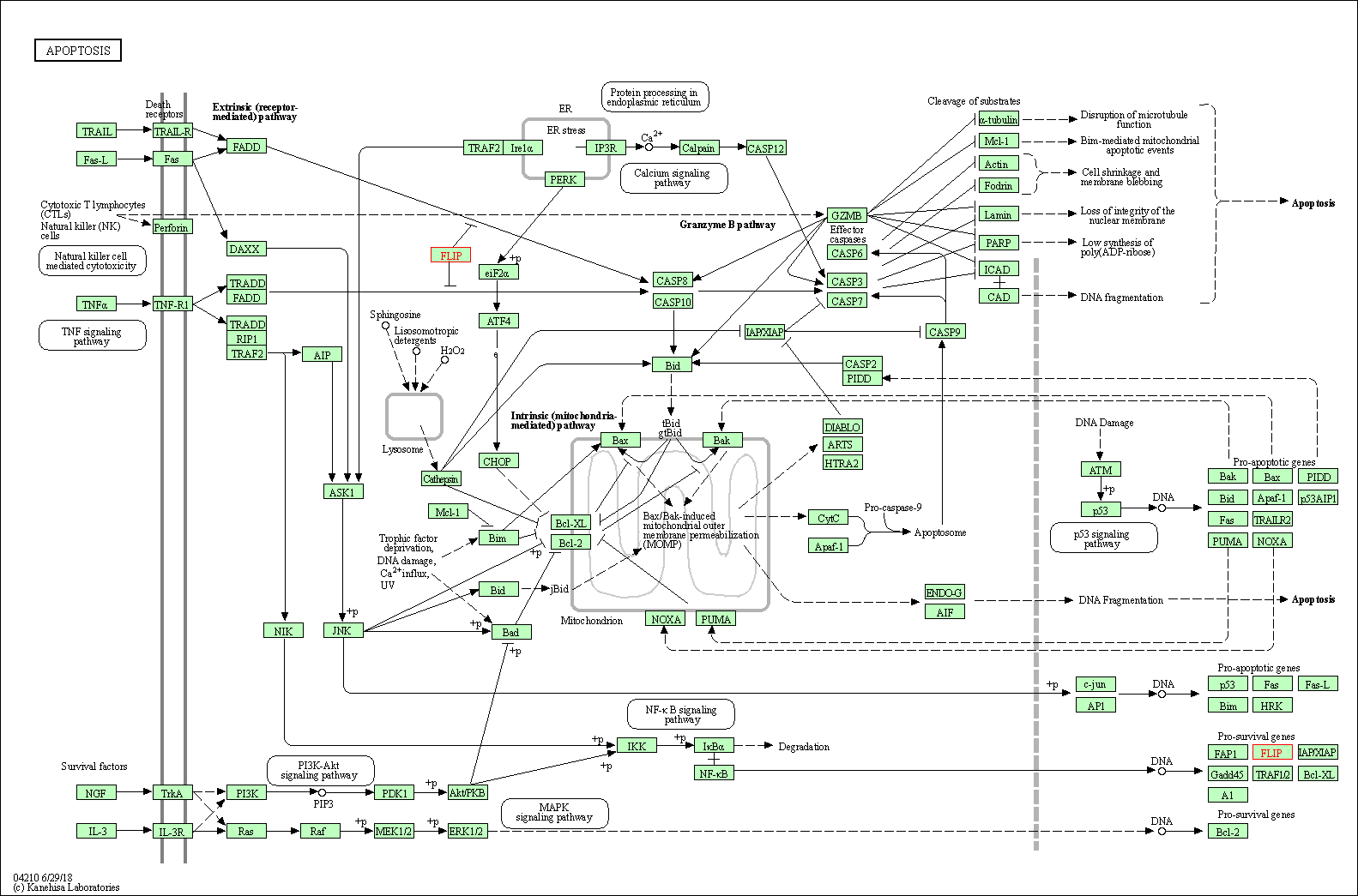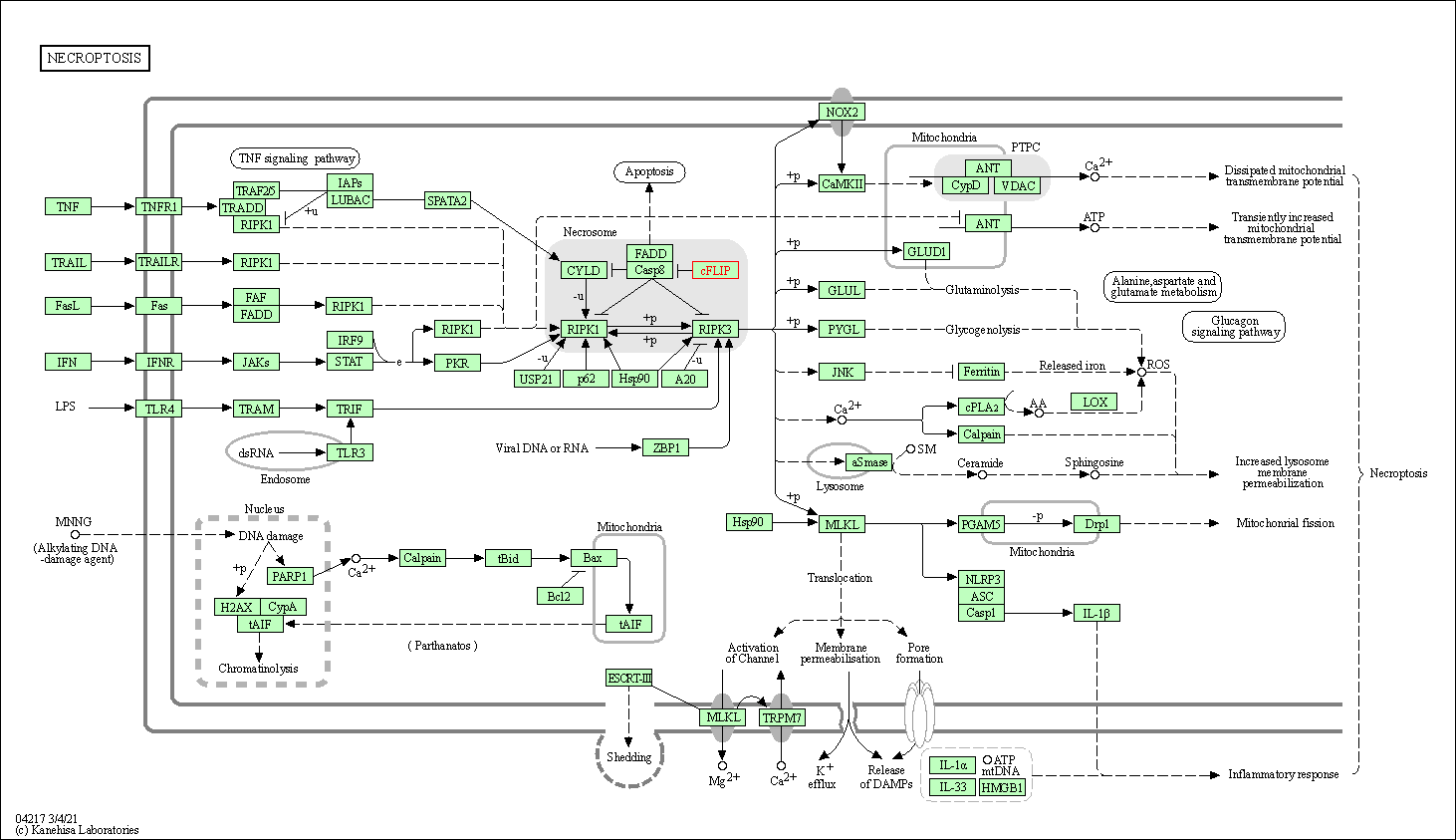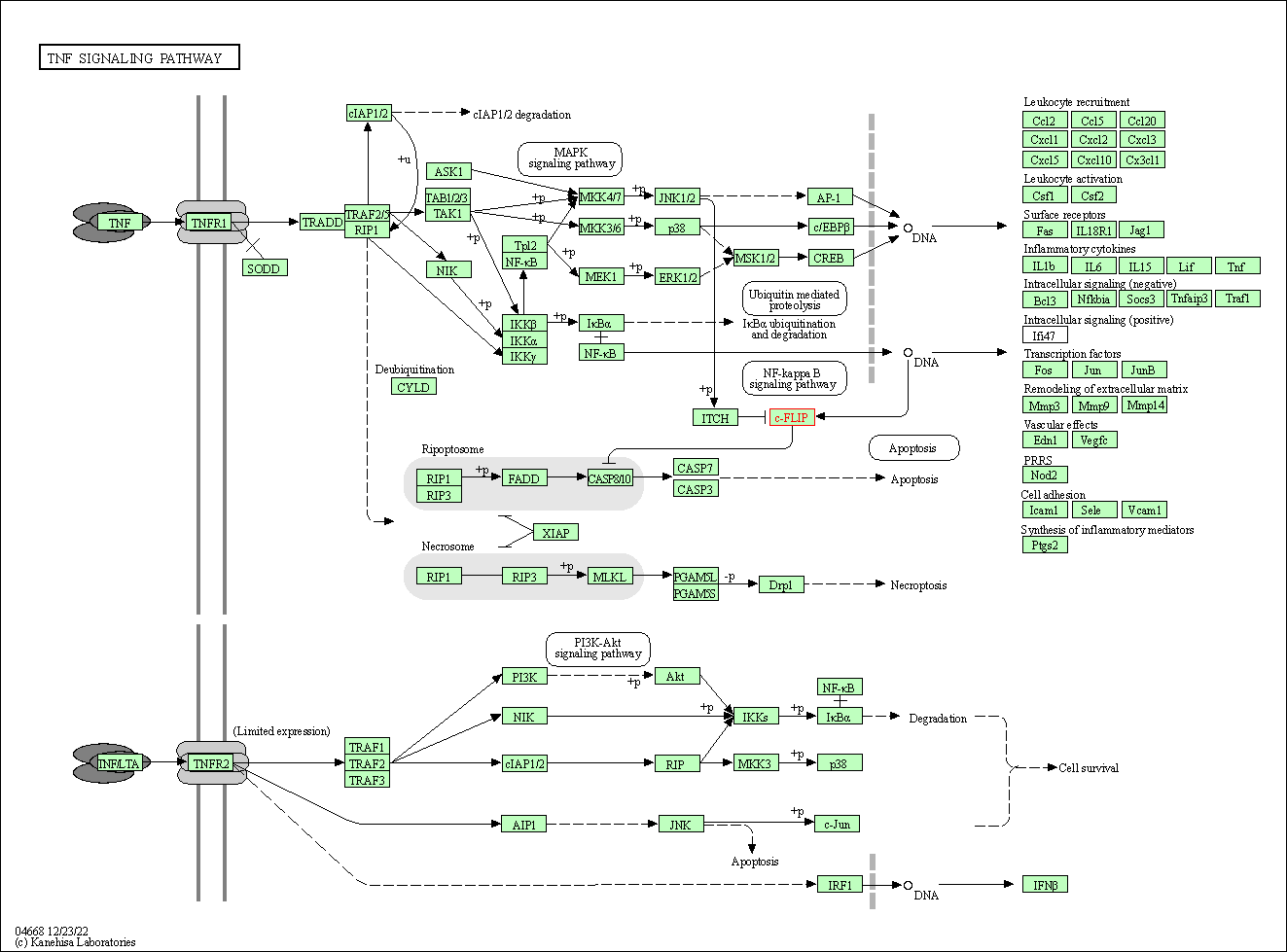Target Information
| Target General Information | Top | |||||
|---|---|---|---|---|---|---|
| Target ID |
T14306
(Former ID: TTDI02464)
|
|||||
| Target Name |
CASP8-FADD-like regulator (CFLAR)
|
|||||
| Synonyms |
cFLIP; c-FLIP; Usurpin; MRIT; MACHrelated inducer of toxicity; MACH-related inducer of toxicity; Inhibitor of FLICE; IFLICE; I-FLICE; FLAME1; FLAME-1; FADDlike antiapoptotic molecule 1; FADD-like antiapoptotic molecule 1; Cellular FLICElike inhibitory protein; Cellular FLICE-like inhibitory protein; Casper; Caspaselike apoptosis regulatory protein; Caspaseeightrelated protein; Caspase-like apoptosis regulatory protein; Caspase-eight-related protein; Caspase homolog; CLARP; CASP8AP1; CASP8 and FADDlike apoptosis regulator subunit p12; CASP8 and FADDlike apoptosis regulator; CASP8 and FADD-like apoptosis regulator; CASH
Click to Show/Hide
|
|||||
| Gene Name |
CFLAR
|
|||||
| Target Type |
Literature-reported target
|
[1] | ||||
| Function |
Acts as an inhibitor of TNFRSF6 mediated apoptosis. A proteolytic fragment (p43) is likely retained in the death-inducing signaling complex (DISC) thereby blocking further recruitment and processing of caspase-8 at the complex. Full length and shorter isoforms have been shown either to induce apoptosis or to reduce TNFRSF-triggered apoptosis. Lacks enzymatic (caspase) activity. Apoptosis regulator protein which may function as a crucial link between cell survival and cell death pathways in mammalian cells.
Click to Show/Hide
|
|||||
| BioChemical Class |
Peptidase
|
|||||
| UniProt ID | ||||||
| Sequence |
MSAEVIHQVEEALDTDEKEMLLFLCRDVAIDVVPPNVRDLLDILRERGKLSVGDLAELLY
RVRRFDLLKRILKMDRKAVETHLLRNPHLVSDYRVLMAEIGEDLDKSDVSSLIFLMKDYM GRGKISKEKSFLDLVVELEKLNLVAPDQLDLLEKCLKNIHRIDLKTKIQKYKQSVQGAGT SYRNVLQAAIQKSLKDPSNNFRLHNGRSKEQRLKEQLGAQQEPVKKSIQESEAFLPQSIP EERYKMKSKPLGICLIIDCIGNETELLRDTFTSLGYEVQKFLHLSMHGISQILGQFACMP EHRDYDSFVCVLVSRGGSQSVYGVDQTHSGLPLHHIRRMFMGDSCPYLAGKPKMFFIQNY VVSEGQLEDSSLLEVDGPAMKNVEFKAQKRGLCTVHREADFFWSLCTADMSLLEQSHSSP SLYLQCLSQKLRQERKRPLLDLHIELNGYMYDWNSRVSAKEKYYVWLQHTLRKKLILSYT Click to Show/Hide
|
|||||
| 3D Structure | Click to Show 3D Structure of This Target | AlphaFold | ||||
| HIT2.0 ID | T74D4Y | |||||
| Cell-based Target Expression Variations | Top | |||||
|---|---|---|---|---|---|---|
| Cell-based Target Expression Variations | ||||||
| Different Human System Profiles of Target | Top |
|---|---|
|
Human Similarity Proteins
of target is determined by comparing the sequence similarity of all human proteins with the target based on BLAST. The similarity proteins for a target are defined as the proteins with E-value < 0.005 and outside the protein families of the target.
A target that has fewer human similarity proteins outside its family is commonly regarded to possess a greater capacity to avoid undesired interactions and thus increase the possibility of finding successful drugs
(Brief Bioinform, 21: 649-662, 2020).
Human Tissue Distribution
of target is determined from a proteomics study that quantified more than 12,000 genes across 32 normal human tissues. Tissue Specificity (TS) score was used to define the enrichment of target across tissues.
The distribution of targets among different tissues or organs need to be taken into consideration when assessing the target druggability, as it is generally accepted that the wider the target distribution, the greater the concern over potential adverse effects
(Nat Rev Drug Discov, 20: 64-81, 2021).
Human Pathway Affiliation
of target is determined by the life-essential pathways provided on KEGG database. The target-affiliated pathways were defined based on the following two criteria (a) the pathways of the studied target should be life-essential for both healthy individuals and patients, and (b) the studied target should occupy an upstream position in the pathways and therefore had the ability to regulate biological function.
Targets involved in a fewer pathways have greater likelihood to be successfully developed, while those associated with more human pathways increase the chance of undesirable interferences with other human processes
(Pharmacol Rev, 58: 259-279, 2006).
Biological Network Descriptors
of target is determined based on a human protein-protein interactions (PPI) network consisting of 9,309 proteins and 52,713 PPIs, which were with a high confidence score of ≥ 0.95 collected from STRING database.
The network properties of targets based on protein-protein interactions (PPIs) have been widely adopted for the assessment of target’s druggability. Proteins with high node degree tend to have a high impact on network function through multiple interactions, while proteins with high betweenness centrality are regarded to be central for communication in interaction networks and regulate the flow of signaling information
(Front Pharmacol, 9, 1245, 2018;
Curr Opin Struct Biol. 44:134-142, 2017).
Human Similarity Proteins
Human Tissue Distribution
Human Pathway Affiliation
Biological Network Descriptors
|
|
|
There is no similarity protein (E value < 0.005) for this target
|
|
Note:
If a protein has TS (tissue specficity) scores at least in one tissue >= 2.5, this protein is called tissue-enriched (including tissue-enriched-but-not-specific and tissue-specific). In the plots, the vertical lines are at thresholds 2.5 and 4.
|





| KEGG Pathway | Pathway ID | Affiliated Target | Pathway Map |
|---|---|---|---|
| NF-kappa B signaling pathway | hsa04064 | Affiliated Target |

|
| Class: Environmental Information Processing => Signal transduction | Pathway Hierarchy | ||
| Autophagy - animal | hsa04140 | Affiliated Target |

|
| Class: Cellular Processes => Transport and catabolism | Pathway Hierarchy | ||
| Apoptosis | hsa04210 | Affiliated Target |

|
| Class: Cellular Processes => Cell growth and death | Pathway Hierarchy | ||
| Necroptosis | hsa04217 | Affiliated Target |

|
| Class: Cellular Processes => Cell growth and death | Pathway Hierarchy | ||
| TNF signaling pathway | hsa04668 | Affiliated Target |

|
| Class: Environmental Information Processing => Signal transduction | Pathway Hierarchy | ||
| Degree | 20 | Degree centrality | 2.15E-03 | Betweenness centrality | 9.63E-05 |
|---|---|---|---|---|---|
| Closeness centrality | 2.25E-01 | Radiality | 1.40E+01 | Clustering coefficient | 4.11E-01 |
| Neighborhood connectivity | 2.80E+01 | Topological coefficient | 1.21E-01 | Eccentricity | 11 |
| Download | Click to Download the Full PPI Network of This Target | ||||
| Target Regulators | Top | |||||
|---|---|---|---|---|---|---|
| Target-regulating microRNAs | ||||||
| Target-interacting Proteins | ||||||
| References | Top | |||||
|---|---|---|---|---|---|---|
| REF 1 | Targeting CASP8 and FADD-like apoptosis regulator ameliorates nonalcoholic steatohepatitis in mice and nonhuman primates. Nat Med. 2017 Apr;23(4):439-449. | |||||
If You Find Any Error in Data or Bug in Web Service, Please Kindly Report It to Dr. Zhou and Dr. Zhang.

